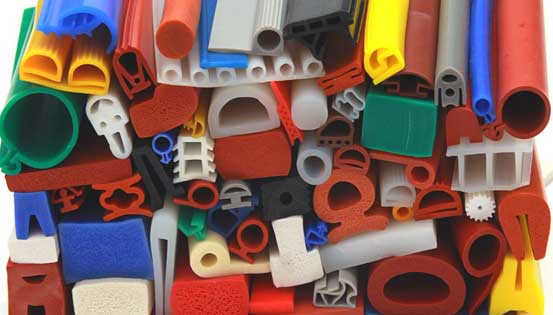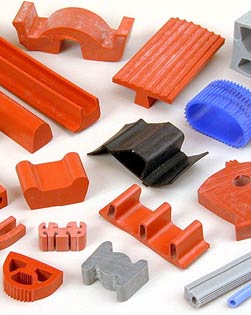There is a wide variety of rubber extruded products used in various purposes, both industrial as well as commercial. Rubber is one of the most common material used in almost every industrial application. Its resilience or elasticity or flexibility makes it an effective choice for applications which involve shock absorption, sealing and fluid transportation.
Advantages of Rubber Extrusion
There are different rubber processing methods but of all the methods, extrusion remains a popular choice for many manufacturers. This is because, extruded rubber products can be produced in a neat, uniform manner. A great variety of shapes can be produced, including hollow designs for any industrial need, that greatly reduce material cost and create flexible, lightweight products. Rubber materials are in great demand, making rubber extrusions and molded rubber effective ways to produce these materials.


Types of Extruded Rubber Products
Extruded rubber products are applied in a wide range of sealing and gasketing applications. They are available in various compounds and styles to meet specific end-use requirements involving various factors like size, tolerance, configuration, cost and performance. Some extruded rubber products are as follows:
- Rubber Bumper
- Rubber Bushes
- Rubber Cord
- Rubber Diaphragm
- Rubber Gasket
- Rubber Hose
- Rubber Shapes
- Rubber Stripes and Profiles
- Rubber Tubing
Rubber Extrusion: The Process
The process of extruding can be compared to squeezing of toothpaste from a tube and the paste takes the shape of the tube opening. Rubber material is processed through an extruder, during the rubber extrusion process. There are two main components of rubber extruders:
- A small heated drum: As the material enters the drum, it is softened through heating and then pressurized through the rotation of a screw and
- A die: The pressure pushes the rubber through the die, located at the end of the extruder.
Depending on the result desired, pre-heating of the material is optional. The rubber emerges from the extruder in a profile which resembles the die shape. As the possibilities of die design are nearly limitless, so also the number of possible extruded rubber profiles. After being extruded, the rubber material is cured using various methods such as salt bath, autoclave, convection, hot air, microwave and mandrel.
Applications of Extruded Rubber Products
Extruded rubber products are used in a wide variety of industries like Aerospace, Automotive, Lighting, Appliance, Electronics, Construction and Medical industries
Types of Rubber Extrusion Process
- Co-Extrusion: This is considered to be a variation of the basic extrusion process. This process allows for the convergence of rubber materials that contain different properties like color and consistency.
- Cold feed extrusion: This is the process of extrusion without pre-heating. This process is best suited to produce hoses, profiles, cable and sheaths.
- Hot feed extrusion: This on the other hand is the extrusion process which involves the pre-heating before performing the extrusion process.
- Pin barrel extruders: This process performs with many pins protruding from the cylinder wall toward the screw's center and enhances the mixing and dispersing of the rubber when it is kneaded between the screws and the cylinder. This method can be applied for diverse applications.
- Vented extruders: This process has screws of an original and unique design and it is easy to maintain and occupies very little floor space.
- Anti Vibration Mountings
- Automobile Rubber Products
- Calendered Rubber Products
- Extruded Rubber Products
- Medical Rubber Products
- Metal Bonded Components
- Rubber Adhesives & Sealants
- Rubber Ball
- Rubber Bands
- Rubber Beading
- Rubber Bearing
- Rubber Belt
- Rubber Buckets
- Rubber Bullets
- Rubber Cable
- Rubber Coating
- Rubber Duct
- Rubber Expansion Joints
- Rubber Flooring/Matting
- Rubber Footwear
- Rubber Gloves
- Rubber Injection Parts
- Rubber Lining
- Rubber Magnets
- Rubber Molded Products
- Rubber Pads
- Rubber Rollers
- Rubber Stopper
- Rubber Suit
- Rubber Track
- Rubber Valve
- Rubber Balloon
- Rubber Stamps
- Rubber Fenders
- Acrylic Rubber (ACM)
- Butadiene Rubber (BR)
- Butyl Rubber (IIR)
- Chlorosulfonated Polyethylene(CSM)/ Hypalon
- Ethylene Propylene Diene Monomer
- Fluoroelastomers (FKM)/Viton
- Isoprene Rubber (IR)
- Nitrile Rubber (NBR)
- Perfluoroelastomer (FFKM)
- Polychloroprene (CR)/Neoprene
- Polysulfide Rubber (PSR)
- Silicone Rubber (SiR)
- Styrene Butadiene Rubber
How to Make a Custom Rubber Stamp?
Whenever designing a custom stamp for your company, never compromise on its quality because in the end it is the most...
Read MoreLatex and Silicone Rubber Tubing - A Comparison!
Many industries use rubber tubing for various purposes. In fact, various types of rubber tubing are used for different applications...
Read MoreSilicone vs Acrylic Adhesive- A Comparison
Silicon and acrylic adhesives are those rubber adhesives that are widely used in Polyimide tapes. In fact, the polyimide...
Read More

